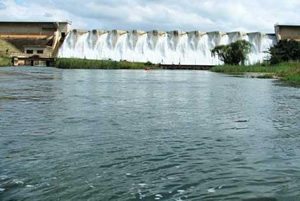 Improving Supply of Quality Water in the Kwazulu-Natal Province
Improving Supply of Quality Water in the Kwazulu-Natal Province
The Department of Water Affairs (DWA) through the Trans-Caledon Tunnel Authority (TCTA) has funded the implementation of the MooiMgeni Water Transfer Scheme (MMWTS) in KwaZulu-Natal to supply water to approximately five million people as well as the industrial sectors in the Durban and Pietermaritzburg regions, the economic hub of the province.
The MMWTS Phase 2 entails the construction of the Spring Grove dam on the MooiMgeni river about 2km from Rosetta, the construction of a water transfer scheme to transfer water to Midmar dam, the realignment of access roads that will be inundated by the dam, the resettlement of people, graves and certain fauna and flora affected by the inundation of the land.
The construction of the Spring Grove dam components entail a roller compacted concrete (RCC) dam with an earth embankment, three gauging weirs, and re-alignment of private access roads. When complete, the dam wall will be 37m high and 607m long with a spillway height of 37 m, spillway length of 70m and ogee crest spillway.
The dam with a catchment area of 344 km2 will have a gross storage volume of 139.5 million m3 covering a water surface area of 1,022 ha at full supply. In addition, the firm yield of the dam will be 60 million m3 per annum while the outlet capacity will be 29.5m3 /s.
As part the development, a new water transfer scheme will also be constructed to transfer water from the Spring Grove dam to the Mbofana River, a tributary of the Mgeni River upstream of the Midmar Dam.
The new water transfer scheme will consist of a 5.8MW pump station, with a maximum pumping capacity of 4.5m3 per second constructed downstream of the dam on the right bank of the Mooi River. A rising main with a diameter of approximately 1,800 mm is being constructed from the Spring Grove Dam pump station to a new Break Pressure Tank at the watershed in Gowrie Village. The new 6km pipeline will cross the small holdings in Rosetta for the first 3 km before joining the route of the existing Mearns pipeline and returning to the break pressure tank.
A new break pressure tank with a sufficient capacity for both the MMTS 1 and 2 systems is being designed to blend in with the surrounding buildings in order to enhance the aesthetic appeal of the area.In addition, a new 900mm diameter gravity main will be constructed alongside the existing MMTS-1 pipeline. The pipeline is approximately 8 km long and will discharge at the existing outfall on the Mpofana River.
The existing outfall works will be upgraded to accommodate theMMTS-2 system. In conjunction with the new MMTS-2 scheme, the original Mearnssystem is being refurbished. A team of specialists assessed the original Mearns pipeline and the mechanical and electrical equipment in the Mearns pump station and TCTA decided to proceed with the recommended refurbishments.
Professional Team
Principal Department of Water Affairs (DWA)
Implementing Agent for the MMTS-2 TCTA
Project Partner Umgeni Water
Consulting Engineer BKS (Pty) ltd
Contractor Group Five-Pandev Spring Grove Joint Venture
Geotechnical Engineering Knight Piesold
Environmental Management ILISO
Social Aspects Nomad Consulting
RCC Specialist Fosce
Environmental Control Officer NEMAI Consulting
Heritage Mitigation Aspects University of Pretoria
